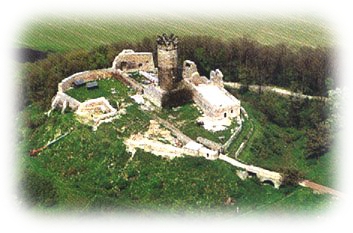With a deed of 1st
May 704 the Duke of Thuringia Hedan II gave Castello Mulenberge
together with goods in Mulenberge (Mühlberg) Arnestati
(Arnstadt) and Monhora (Großmonra) to the missionary
and bishop Willibrord of Utrecht. Whether this fort was already
at the site of todays Mühlburg, is not assured. Most likely, their
history goes back to the time of the Thuringian kingdom and its subjugation
by the Franks in 531.

Chronology:
*
In 1000 the castle came into possession of the Counts of Orlamünde.
* In 1088 Emperor Henry IV besieged the castle
and additional the castle Gleichen on the other side, but without
success.
* In 1130 the castle became as part of the heritage
of the male line extinct earls of Weimar-Orlamünde together
with peers in the castle owned by the Archdiocese of Mainz.
* In 1140 Count Meinhard I obtained the Mühlberg
as a fiefdom.
* In 1211 Count Meinhard III escorted, as
a suitor of the Thuringian Landgrave Hermann I, the four-year
old Elisabeth of Hungary to the Wartburg.
The Meinhards,
now called Counts of Mühlburg, acquired in 1220 the neighboring
fortress Wachsenburg. They died off in 1242 with Meinhard
III and Mainz retracted the vacant fief.
*
In 1248 Count Berthold of Henneberg became the First Captain
of the castle.
* In 1310 Erfurt started an - but also unsuccessful
- attack at the castle and then bought the castle in 1357. It was expanded
to form a solid bulwark and served until 1590 when the Mühlberg
office passed to Saxony-Weimar. The mission: securing trade
routes of Erfurt (copper road).
* In 1375 the Castellan, Edler von Hellbach,
and the owner of the castle, the Count von Gleichen (probably Ernst
II) feuded with each other.
* 1521 Hermann von Hoff became Castle Captain
and accompanied Martin Luther to the Diet of Worms.
* 1592 the Duke of Weimar aquired the the castle and
in 1635 sold it back to the Duke of Altenburg.
* In 1665 Mainz took over again the office with the
now greatly dilapidated castle before it became an enclave to the Kingdom
of Prussia in 1815, surrounded by Gotha area.
* In 1802 the town and the castle was delivered to
Prussia in the wake of the German Mediatisation.
* In 1806 the castle became under French rule.
* In 1815 the castle was redeliverd back to Prussia
and with the castle Gleichen and other possessions also into
the private property of the Field Marshal Baron Muffling.
* From 1903 'till 1907 the dungeon was expanded to
a lookout and equipped with battlements.
* By 1930 the former castellan, Richard Opel,
was able to find the remains of the medieval Radegundis Chapel,
which he uncovered a man's height.
* In 1945 the walls were carried off of ignorance,
so today only the foundations are visible.
* Since the early 1970s, the castle is graduallyrepaired
by the citizens of Mühlberg. Today the ruin houses a small museum
which can be visited.
* In June 1987, the 1400th anniversary of the death
of Radegund and a memorial stone was attached within the foundation
walls of the chapel.
Some famousness
the Mühlburg obtained by Gustav Freytag, whose novel "Das
Nest der Zaunkönige" from the novel series "Die
Ahnen der Burg". But the Mühlburg never played a major
role in the history of Thuringia and was not in possession of a race
that could, like the wrens engage in a quarrel with the German king.
A trail
connecting the Mühlburg with the two other castels of the Drei
Gleichen (the Wachsenburg and the Burg Gleichen)
was named Gustav-Freytag-Wanderweg.